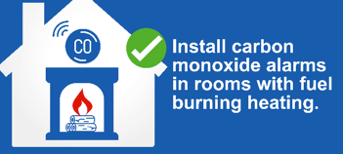Carbon monoxide (CO) safety

Carbon monoxide (CO) is a silent and deadly gas that is odourless, colourless, and tasteless. It can be generated by malfunctioning or improperly vented appliances, causing serious health issues and even death. To safeguard your household, it is crucial to be aware of carbon monoxide risks and implement these essential tips for CO safety in your home.
- Install CO detectors.
- Place carbon monoxide detectors on every level of your home, especially near sleeping areas.
- Install them according to the manufacturer's instructions, typically at a low level, as CO tends to sink to the ground.
- Regularly check and replace the batteries to ensure they are functioning correctly.
- Regular appliance maintenance.
- Schedule regular maintenance for all fuel-burning appliances, including furnaces, water heaters, gas stoves, fireplaces, and boilers.
- Have a qualified technician inspect and service these appliances annually to ensure they are functioning properly and not emitting dangerous levels of CO.
- Find an approved trader
- Proper ventilation.
- Ensure that all fuel-burning appliances, such as gas stoves and dryers, have proper ventilation systems.
- Regularly check that vents and chimneys are clear of debris and not obstructed.
- Proper ventilation allows for the safe discharge of any hazardous gases, including CO.
- Never use outdoor appliances indoors.
- Do not use outdoor appliances, such as generators, charcoal grills, or camping stoves, indoors or in enclosed spaces.
- These appliances are not designed for indoor use and can produce high levels of CO, creating a severe health risk.
- Be cautious with fireplaces.
- When using a fireplace, make sure the flue is open and functioning correctly to allow proper ventilation.
- Avoid closing vents or blocking off airflow. Have your fireplace and chimney inspected regularly and keep them clean to minimize the risk of CO accumulation.
- Educate yourself and family.
- Educate yourself and your family members about the signs and symptoms of CO poisoning, such as headaches, nausea, dizziness, confusion, and flu-like symptoms.
- Make sure everyone knows the importance of immediately evacuating the premises if these symptoms occur and seeking medical attention.
- Be mindful of cars and garage safety.
- Never leave a car engine running inside a closed garage, even with the garage door open. The fumes can quickly accumulate and seep into your home.
- Avoid warming up your car in an enclosed area, such as a closed garage, as it can lead to dangerous CO levels.
- Tenant awareness.
- If you are a tenant, ensure that your landlord provides working CO detectors within your rental property.
- Familiarise yourself with the location of these detectors and immediately report any malfunctioning units to your landlord.
Carbon monoxide is a deadly gas that can be present in your home. By implementing these top tips for CO safety, including installing CO detectors, maintaining fuel-burning appliances, ensuring proper ventilation, and educating yourself and your family, you can protect your household from the dangers of carbon monoxide. Remember, early detection and prevention are crucial to keeping your home safe from CO hazards.